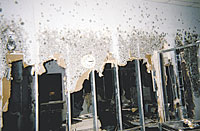
Like the Energizer Bunny, mold keeps going and going and going. And, unfortunately for contractors, lawsuits keep coming and coming and coming. And those contractors without mold insurance will be the ones hurting down the litigation road, warned Robert Snyder, who heads the Air Conditioning Contractors of America's (ACCA's) Insurance Service.
In Snyder's estimation, now more than ever HVACR contractors must understand their mold exposure and how they can manage it. According to the vice president of Environmental Risk Management for The Fedeli Group (Independence, Ohio), one recent phenomenon arising out of the explosion in mold litigation is that experts are increasingly attributing mold growth to the installation, operation, and design of air conditioning systems.
"It is now common for homeowners, commercial building owners, and their insurance companies, through subrogation actions, to assert claims against HVACR contractors for property damage directly resulting from mold growth or for bodily injury to the owner or other building occupants arising from the exposure to mold," he said.
"HVACR contractors will pay staggering legal costs to defend themselves regardless of the validity of the claims asserted against them."
"It's been below the radar screen," he added, referring to mold litigation. "But it's there."
RECENT CLAIM
Last November, for instance, a California family agreed to a $13 million settlement from a lumber company in mid-trial to complete a $22.6 million settlement with their home's contractors and suppliers over mold exposure. According to reports, the family in question sustained severe health complications and the mold in question was blamed for one of their three children sustaining severe brain injuries.Gary and Dana Gorman said they suffered respiratory and sinus problems shortly after moving into a new $1.9 million home in Manhattan Beach in 1999. They stayed in the home for two years before moving because of deteriorating health problems, including brain lesions and cysts suffered by son Kellen Gorman, now age 5, which were revealed in an MRI taken when the child was 3 1/2. An MRI taken when the child was 1 1/2 was reportedly normal. Other family members complained of numerous health problems, including cognitive difficulties, such as memory loss, which has been associated with fungal exposure.
According to court document records, the Gormans said their son became sick because of mold on framing studs that had been improperly stored by Crenshaw Lumber Co. Inc. of Gardena, Calif.
If the parties disagreed on where the mold came from or how the Gormans' son became ill, they all agreed that the settlement will have an impact across the building industry. And, in the eyes of Larry Olson, who owns Crenshaw Lumber with his brother, this impact is not good news for others in the construction business.
"Mold is the new asbestos," Olson told the Daily Breeze, the local newspaper based in Torrance, Calif. "It's the latest attorney thing to drum up money."
Translation: Don't let your guard, or your insurance coverage, down.

CATCH 22 SITUATION?
Insurance companies from around the country have seen toxic mold claims increase from approximately $7.9 million in the first quarter of 2000 to approximately $94 million in the first quarter of 2001. Over 9,000 mold claims have been processed in the last few years, including more than 1,000 against sellers of real estate property, 2,000 against builders and developers, and 1,000 involving condominium and/or homeowner associations.Of course, fueling the "mold hysteria" has been high-profile cases involving celebrities, including Erin Brokovich and Ed McMahon.
"There have been claims that never hit the news because carriers and contractors generally settle claims without a lot of fanfare and the insurance contract has no public notification provision in it," said Snyder. "The biggest do surface in some type of human interest story or horror story."
At the same time, the reason for the mold claims explosion involves modern construction methods. According to the Energy Efficient Building Association (EEBA), many modern IAQ dilemmas are associated with three major advances in energy efficiency: thermal insulation, tighter building enclosures and new materials, and heating and cooling systems.
"This causes two things: less air change with fresh outdoor air and trapped moisture," said Snyder. "Scientific evidence has shown that the air in homes can be even more polluted than the outdoor air in large, industrialized cities. Many people are spending 90 percent of their time indoors, too."
Because of liability exposure and potential legal and expert costs, HVACR contractors would like to shift the mold risk to the insurance industry. However, the insurance industry is not offering affordable options, if any options at all. It is seemingly a Catch 22 situation, but Snyder believes ACCA's mold risk management and insurance program is the best solution for contractors.
"If you are certified through a training process and implement a risk management program, you are prequalified by AIG for mold insurance coverage," said Snyder.
"The average claim reserve set by carriers when first notified of a mold incident is $250,000. This is a significant amount of money to expect an unassuming contractor to have to provide to defend or settle an average property damage claim allegation.
"This number does not anticipate any bodily injury either; those claims can be into the millions. The average settlement that our [ACCA] members are talking to me about when they have been directly involved is in the range of $300,000 to $400,000."

ACCA'S PROGRAM
According to Snyder, select insurance carriers are interested in insuring contractors that take the ACCA protocol training "because ‘best practices' make better contractors.""Lower premiums are starting to make the environmental coverage our members need and want affordable for the smaller members," said Snyder.
ACCA's program is threefold. The first segment is an educational session, whereby contractors learn all about mold and how it can grow indoors. This segment also includes reviewing recent developments in mold litigation from the perspective of an HVACR contractor. In the second phase, contractors are provided mold protocol and training, plus an overview of risk management techniques, all designed to protect the contractor from exposure to mold claims.
"The purpose of the training is to give HVACR contractors information, materials, and protocol," said Snyder.
"Once pre-qualified, a company becomes eligible to participate in the ACCA Insurance Services mold insurance program, which provides the contractor with mold insurance liability coverage and a defense."
Training is offered regionally, explained Snyder, who noted that webcast training is in the offing. At the conclusion of the training, a test is administered. At the training, each participant is given a training video to be played to all front-line employees, "who will likewise be tested," he said.
"General contractors, owners, and institutional clients like schools, hospitals, and even hotels are now starting to ask our members for evidence of environmental coverage on certificates of insurance with bids," said Snyder.
"I expect that more and more demand from owners and higher-tier contractors will drive the cost of this coverage down, as more insurance carriers enter the market to provide for the demand. ACCA is ahead of the curve in offering protection that brings a good contractor back to standard coverage."
Snyder is quick to point out that contractors are not the experts in the field of mold investigation, identification, or remediation, nor are they experts in building envelope investigations or identifying the cause and origin of moisture or mold - "or anything other than installation, operation, and maintenance-service of HVAC equipment."
"Therefore, you are not qualified to answer customers or customer questions pertaining to moisture intrusion or mold," he said. "This training does not make you experts in mold. We leave that to the scientists and mold professionals."
In the end, Snyder said contractors should not hold themselves out to customers as having expertise in the areas of water intrusion or mold. Rather, he suggested providing the customer, building owner, or property manager the program's nonexclusive list of approved consultants for each to get answers to their respective questions.
"Again, you are not recommending or endorsing the expertise of any consultant on the list," he said. "Rather, the list is just a number of suggestions of consultants who work in the mold area who might be able to help answer your customer's questions."
In the end, the training ACCA offers is designed to give a contractor the needed language for each document presented, a protocol to follow, and, last but certainly not least, the needed mold insurance. "Nothing will prevent you from being sued," cautioned Snyder, "but modifying the language in your documents will put you in a better position for your defense in the event that a lawsuit is filed. To be eligible for the insurance program, you must implement the suggested language."
For more information, contact ACCA at www.acca.org or e-mail Snyder at rsnyder@thefedeligroup.com.
Publication date: 06/05/2006



